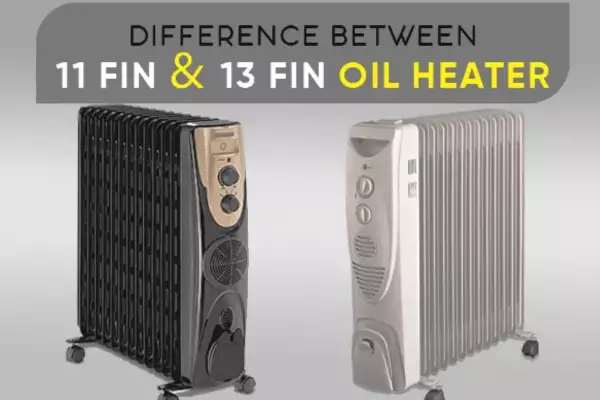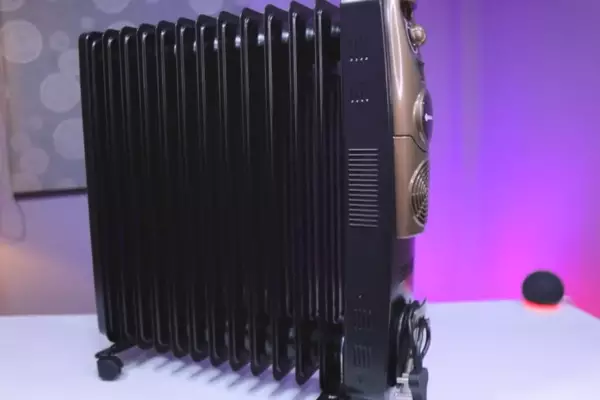Oil heaters, an effective solution for bone-chilling winters, can make your home cozy and comfortable. With energy efficiency and uniform heating, they’re a popular choice among consumers. However, knowing the correct model for your needs can be tricky.
The key aspect that distinguishes these heaters is the number of fins. This directly impacts the heating capability and the ideal room size for the heater. Simply put, the number of fins in your heater can make a significant difference in its performance.
This article dives into the specifics of oil heaters with different fin numbers – 5, 9, 11, and 13. We will also guide you on how the room size affects the choice of heater. Let’s delve into the fascinating world of oil heaters.
Contents
Basics of Oil Heaters
Working Principle of Oil Heaters
Oil heaters operate on the principle of convection heating. The internal heating element heats the oil inside, and the heat is then transferred to the metal walls of the heater. The fins of the heater facilitate heat dispersal in the room.
Differentiating Factor: The Fins
The “fins” in an oil heater are the metal pieces attached to the body of the heater. These fins play a vital role in heating the room. The more the fins, the larger the surface area for heat dispersal.

Significance of Fin Numbers
The number of fins in an oil heater affects its heating capability. A heater with more fins has a larger heating surface, thus providing more warmth. However, it also consumes more power.
5 Fin Oil Heater
General Specifications
The 5 fin oil heater is the most compact model among the oil heaters. Typically operating at a lower wattage around 1000W, it provides adequate heating for smaller spaces. These heaters are designed with mobility in mind, featuring a lightweight structure and often equipped with caster wheels for easy movement.
Ideal Usage Scenarios
Small rooms of about 10 square meters are the perfect match for 5 fin heaters. They are ideal for personal spaces such as a compact home office, a small bedroom, or even a baby’s nursery. Their portability also makes them suitable for supplemental heating if a central heating system doesn’t quite reach certain spots.
Pros and Cons
5 fin heaters are pocket-friendly, both in terms of purchase price and energy consumption. They are also space-efficient, fitting well into tight spaces. However, their heating capacity is not suited for larger rooms, and they may take a longer time to heat the space compared to heaters with more fins.
9 Fin Oil Heater
General Specifications
9 fin oil heaters are middle-ground models, typically featuring power ratings between 2000W and 2400W. They offer a larger heating surface than 5 fin models, ensuring better heat distribution and faster warming of rooms.
Ideal Usage Scenarios
These heaters are a perfect match for medium-sized rooms, typically around 15-20 square meters. Think of spaces like your living room, a master bedroom, or a moderately sized office space. They are also ideal for households in areas with moderate winters.
Pros and Cons
9 fin heaters offer a balance between size, portability, and heating performance. They can heat up larger spaces more effectively than 5 fin heaters, but they also consume more energy. These models might be slightly heavier and may require more space due to their larger size.
11 Fin Oil Heater
General Specifications
With an even larger heating surface, 11 fin heaters are high-performance models typically available in 2500W power ratings. These heaters can deliver high heat output, ensuring quick and uniform heating.
Ideal Usage Scenarios
11 fin oil heaters are well-suited for large rooms that measure around 20-25 square meters. These could be large bedrooms, living rooms, or spacious office environments. They’re an excellent choice for areas experiencing severe winters, as they can provide warmth more effectively.
Pros and Cons
While 11 fin heaters provide superior heating, they consume more power, which could lead to higher energy bills. They are also heavier than their smaller counterparts and may not be as portable. Plus, you’ll need more space to accommodate these heaters, which could be a consideration if you have a space-constrained room.

13 Fin Oil Heater
General Specifications
The 13 fin oil heater is the most powerful model in this range. It often comes with a power rating of 2900W or more, ensuring maximum heat output. These models provide a high level of heat and can warm up a room in less time.
Ideal Usage Scenarios
These high-performance heaters are ideal for large, open spaces or rooms larger than 25 square meters. Consider them for large open-plan living areas, spacious office environments, or large bedrooms. They’re perfect for those who live in areas with very cold winters.
Pros and Cons
13 fin heaters deliver superior heating performance, providing quick and efficient heating for large spaces. However, these models are the heaviest and the bulkiest. They consume the most energy, which could increase your utility bills, and their large size may make them a bit difficult to move around or store.
Room Size and Fin Oil Heater
The number of fins on your oil heater, in conjunction with the power rating, determines the heater’s effectiveness in a given room size. Here we’ll delve into the specifics of different room sizes and how they pair with the various oil heater models.
9 Fin Oil Heater Room Size
A 9 fin oil heater, with a typical power rating of 2000W to 2400W, is adept at heating medium-sized rooms. The size of the room that can be adequately heated falls in the range of 15 to 20 square meters. This includes spaces like a medium-sized living room or a larger bedroom. Always remember that these values are approximate and depend on other factors such as insulation, number of windows, and the overall temperature outside.
11 Fin Oil Heater Room Size
The 11 fin oil heater is designed for larger spaces. With a typical power rating of around 2500W, these heaters are suitable for rooms measuring approximately 20 to 25 square meters. Think of large bedrooms, living rooms, or a spacious home office. Again, these estimates are influenced by factors like external temperatures and insulation within your home.
13 Fin Oil Heater Room Size
13 fin oil heaters are the most powerful among the models mentioned. Usually coming with a power rating of 2900W or more, they are capable of heating large, open spaces exceeding 25 square meters. This makes them ideal for open-plan living rooms, large offices, or big bedrooms. Remember, the effectiveness of these heaters can be affected by factors such as room insulation and the number of windows.
How Many Fins Oil Heater Do I Need
Deciding how many fins you need on your oil heater depends on the size of the room you want to heat. For small spaces around 10 square meters, a 5 fin heater should suffice. If your room measures between 15 and 20 square meters, you might want to opt for a 9 fin model. For rooms between 20 and 25 square meters, an 11 fin heater is likely the best fit. Finally, for rooms larger than 25 square meters, a 13 fin model should be your go-to option.

Comparison of Different Fin Oil Heaters
When deciding which oil heater is right for you, it’s crucial to consider the differences in specifications, heating performance, energy consumption, and room size suitability among the different models. Here, we’ll explore how 5 fin, 9 fin, 11 fin, and 13 fin oil heaters stack up against each other.
Heating Performance
The number of fins in an oil heater directly influences its heating performance. More fins mean a larger surface area, enabling more effective heat dispersion. A 5 fin heater, with its smaller heating surface, can’t match the output of larger models. For medium-sized rooms, 9 fin heaters strike a balance between size and heating ability. When it comes to heating larger rooms quickly and effectively, 11 fin and 13 fin models excel.
Energy Consumption
With more power comes greater energy consumption. 5 fin heaters are the most energy-efficient, given their lower wattage, but their heating capacity is also the least. 9 fin models offer a balance, consuming more energy than 5 fin models but less than 11 and 13 fin heaters. The 11 fin and 13 fin models, while providing superior heat output, are also the most energy-intensive.
Portability and Size
Oil heaters with fewer fins are lighter and smaller, making them easier to move around. While a 5 fin heater can be quickly shifted from one room to another, larger models like the 13 fin heaters are heavier and bulkier, requiring more effort to relocate. If you need a portable solution, the 5 or 9 fin models might be the best options. For stationary heat sources, the 11 or 13 fin heaters are the top choices.
Efficiency and Cost Effectiveness
Energy Consumption
Remember, the more fins an oil heater has, the more energy it consumes. So choose a heater that matches your heating needs and is energy efficient.
Cost of Running
While larger heaters provide more warmth, they also come with higher running costs. Balance your needs with your budget to choose the most cost-effective option.
Safety Aspects
Overheat Protection
Most modern oil heaters come with overheat protection. This feature automatically switches off the heater if it overheats, preventing any potential fire hazard.
Safe for Children and Pets
Many oil heaters are safe around children and pets. They come with safety features like cool-touch exteriors and tip-over switches that shut off the heater if it’s knocked over.
Fin Oil Heater Maintenance
Cleaning Process
Regularly dust and clean your oil heater to ensure it runs efficiently. Always unplug the heater before cleaning.
Periodic Inspection
Periodically inspect your oil heater for any signs of damage or wear. Regular inspection will prolong the life of your heater and ensure it remains safe to use.
Frequently Asked Questions
Does More Fins Mean Better Heating?
While more fins do mean a larger heating surface, which can lead to better heat dispersion, it doesn’t necessarily mean better heating. The size of the room and the overall power of the heater are also significant factors.
Are Fin Oil Heaters Safe to Use Overnight?
Most fin oil heaters are designed with safety features like overheat protection and tip-over switches, making them safe to use overnight. However, it’s always recommended to refer to the user manual for specific safety guidelines.
How Can I Increase the Efficiency of My Oil Heater?
You can increase the efficiency of your oil heater by placing it in a central location for better heat distribution, using a timer to control its operation, and insulating your room to prevent heat loss.
Conclusion
Choosing the right oil heater for your home or office requires understanding the significance of fin numbers. The number of fins directly affects the heating performance, making it a crucial factor in your purchase decision.
While a 5 fin heater is perfect for a small room, a 9, 11, or 13 fin heater will be more suitable for larger spaces. Match the heater’s fin number to your room size for efficient and comfortable heating.
Investing in an oil heater is about more than just counting the fins. Consider factors such as energy efficiency, cost, safety features, and maintenance while making a choice. A well-selected oil heater will ensure a warm and cozy winter, making it a worthwhile investment.


very well explained
Thank You So Much.